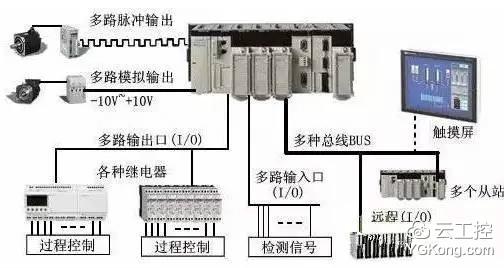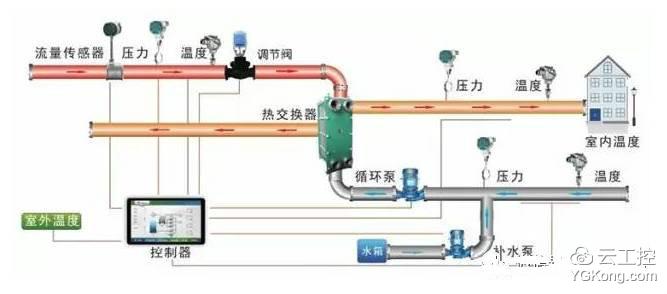Here is a block diagram of a typical PLC control system:

1, for the switch control
PLC's ability to control the amount of switching is very strong. The number of points to be controlled is less than a few dozen or dozens of points, and as many as several hundred, several thousand, or even tens of thousands of points. Because it can be networked, the number of points is almost unlimited, no matter how many points can be controlled. The logical issues of control can be varied: combined, timed, instant, delayed, uncounted, count-asked, fixed-order, random-work, and so on.
The hardware structure of the PLC is variable, and the software program is programmable. It is very flexible when used for control. Multiple sets or multiple sets of programs can be written as needed, and invoked as needed. It is well adapted to the needs of multiple conditions and multiple state transitions in the industrial field.
There are many examples of switching control using PLCs. Metallurgy, machinery, light industry, chemical industry, textiles, etc. are used by almost all industrial industries. At present, the first goal of PLC is that other controllers cannot match it, that is, it can be conveniently and reliably used to control the amount of switches.
2, for analog control
Analog quantity, such as current, voltage, temperature, pressure, etc., its size continuously changes. In industrial production, especially continuous production processes, these physical quantities are often controlled.
As an industrial control electronic device, if the PLC can not control these quantities, it is a big problem. For this reason, PLC manufacturers have carried out a lot of development in this area. At present, not only large-scale and medium-sized machines can perform analog control, but also minicomputers, and can perform such control. PLC carries on the analog quantity control, must dispose the A/D, D/A unit that the analog quantity and the digital quantity mutually transforms. It is also an I/O unit, but it is a special I/O unit.
The A/D unit converts the analog value of the external circuit into a digital quantity and then sends it to the PLC. The D/A unit converts the digital quantity of the PLC into an analog quantity and sends it to the external circuit. As a special I/O unit, it still has I/O circuit anti-jamming, internal and external circuit isolation, and input/output relays (or internal relays, it is also a zone of the PLC working memory, can read and write) exchange information, etc. Features.
The A in the A/D here is mostly current, voltage, and temperature. A in D/A is mostly voltage or current. Voltage, current range is mostly 0 ~ 5V, 0 ~ 10V, 4 ~ 20mA, and some can handle positive and negative values. Here D, minicomputers are mostly 8-bit binary numbers, and medium-to-large-scale are mostly 12-bit binary numbers. A/D, D/A are single and multiplex. Multiple input and output relays are multiple. With A/D, D/A units, the rest of the processing is digital, which is not difficult for information processing PLCs. Medium and large PLCs are more capable of processing, not only adding, subtracting, multiplying, and dividing numbers, but also square roots, interpolations, floating point operations, and PID commands, which can be used to proportionally measure deviations. , differential, integral operation, and then produce the corresponding output, the computer can count it almost all can be counted. In this way, it is entirely possible to implement analog control with a PLC.
PLC carries out analog quantity control, there are unit that A/D, D/A combine together, and can realize control with PID or fuzzy control algorithm, can obtain very high control quality. The advantage of analog control using a PLC is that the analog and digital control can be controlled simultaneously. This advantage is not possessed by other controllers, or the control is not as convenient as the PLC. Of course, if the system is purely analog, using a PLC may not be as good as a regulator in terms of cost performance.
3, for motion control
The actual physical quantity, in addition to switching, analog, and motion control. Such as the displacement of machine parts, often expressed as a digital quantity. Motion control, effective method is NC, digital control technology. This is the computer-based control technology that was born in the United States in the 1950s. It is very popular today and it is also perfect. At present, the ratio of numerical control for metal cutting machines in advanced countries has exceeded 40% to 80%, and some are even higher. PLC is also based on computer technology and is increasingly perfect. PLC can receive counting pulse, the frequency can be as high as several k to several tens of kilohertz, can receive this kind of pulse in a variety of ways, but also can receive many times. Some PLCs also have a pulse output function, pulse frequency can reach tens of k, with these two functions, plus PLC data processing and computing capabilities, if equipped with a corresponding sensor (such as a rotary encoder) or pulse servo The device can be completely controlled according to the principle of NC. High- and mid-range PLCs are also developed with NC units or motion units for point control. The motion unit also implements curve interpolation, which controls the curve motion. Therefore, if the PLC is configured with such a unit, digital control can be performed entirely using NC. Newly-developed sports units have even issued programming languages ​​for NC technology to facilitate digital control using PLCs.

4, for data acquisition
With the development of PLC technology, its data storage area is getting bigger and bigger. For example, the Davison PLC has a data storage area (DM area) of 9999 words. This huge data storage area can store large amounts of data. Data collection can use the counter, cumulatively record the number of pulses collected, and transfer to the DM area periodically. Data acquisition can also use A/D unit, when the analog quantity is converted into digital quantity, it is transferred to the DM area regularly. The PLC can also be configured with a small printer to periodically broadcast data from the DM area.
The PLC can also communicate with the computer. The computer reads the data in the DM area and the computer then processes the data. At this time, the PLC becomes the computer's data terminal. Power users have used PLCs to record user power consumption in real time to realize charging methods with different power consumption times and different pricing, and encouraged users to use more electricity in the event of a power outage to achieve the purpose of reasonable power consumption and electricity saving.
5, for signal monitoring
PLC has many self-test signals and many internal devices. Most users do not fully play their role. In fact, it can be fully used to monitor the PLC's own work or to monitor the control object. For a complex control system, especially the automatic control system, it is necessary to monitor and even further self-diagnose. It can reduce the system failures, and it can also find out if there is a fault. It can improve the cumulative average failure-free operation time and reduce the failure repair. Time, improve the reliability of the system.
6, for networking, communications
PLC networking and communication capabilities are strong, and new networking structures are constantly being introduced. The PLC can be connected with the personal computer for communication, and the computer can be used to participate in the programming and management of the control of the PLC so that the PLC can be used more conveniently.
In order to give full play to the role of computers, a single computer can control and manage multiple PLCs, up to 32. A PLC can also communicate with two or more computers to exchange information to achieve more monitoring of the PLC control system. PLC and PLC can also communicate, one-to-one PLC communication, several PLC communication can be up to tens or hundreds.
PLCs and smart meters, smart actuators (such as inverters) can also be networked to communicate, exchange data, and operate with each other. Can be linked into a remote control system, the system range can be as large as 10 kilometers or more. Can form part of the network, not only PLC, but also high-end computers, all kinds of smart devices can also enter the network. Available bus networks, ring networks are also available. Net can also be networked. Networks and networks can also be bridged. Networking can organize thousands of PLCs, computers, and smart devices in one network. Inter-network nodes can communicate or exchange information directly or indirectly.
Networking and communications are adapting to the needs of today's computer integrated manufacturing systems (CIMS) and intelligent plant development. It enables industrial control from Point to Line to Aero, which allows equipment-level control, production line control, plant management control to be integrated, and can create higher The benefits of this infinitely beautiful prospect have been more clearly displayed in front of our generation.

The above points are focused on quality. In terms of quantity, PLC is big and small. So its control range can also be large or small. Small controls only one device, even one component, one site; large controllable multiple devices, one production line, and even the entire plant. It can be said that industrial control of the size of the occasion, are inseparable from the PLC.
Electric Wall Switch And Socket
Electric Wall Switch And Socket,Electric Wall Switch,Light Sensor Switch,Types Of Light Switches
ZHEJIANG HUAYAN ELECTRIC CO.,LTD , https://www.huayanelectric.com